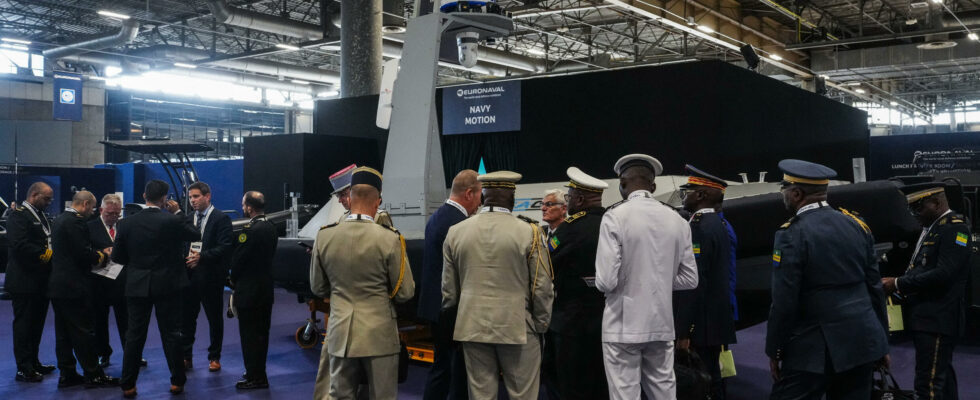Whether underwater or surface, surveillance or combat, drones are making a thunderous entry into military fleets. They were also everywhere in the aisles of the Euronaval show which was held this week near Paris, a true reflection of a “ droneization » massive and rapid military navies of the world.
Slender like a torpedo, streamlined like a boat, there was not an aisle, not a stand without drones at the Euronaval showa production in abundance, the fruit of the imagination of SMEs and major players in the industry, first and foremost Naval group… Pierre Antoine Fliche, responsible for drone product lines: “ At Naval Group, we have two main categories of vehicles, surface drones and underwater drones. In the surface drone, we have the Seaquest range, the smallest of which, the Seaquest S, has already been launched. It is an industrial product which is currently being tested at sea. It has the particularity of being embarkable on frigates and therefore of being able to carry out a whole range of missions for their benefit, as an extension of their capacity. So we are in class 9.30 m, so it remains a large object for all of us, but reduced to the scale of a frigate for example, it is something quite small. It can be armed “.
Complementing the protection of the frigate, the Seaquest S can sail for several days, just like the Ucuv, a 10-ton, 10-meter submarine, the baby of the principal armaments engineer Patrick of the DGA, ” I am the manager in charge of the Ucuv development technology project for Unmanned Combat Underwater Vehicle. Somewhere, we are clearing a new area with this type of machine. No navy in the world today is equipped with these kinds of tools. So we are thinking a lot with the French Navy about what the uses for this type of machine could be. SO de factowhat armament should be entrusted to him “.
The mission of this underwater drone, for example, is to secure the Brest Narrows to ensure the exit of nuclear ballistic missile submarines (SSBNs), the spearhead of deterrence.
In this race for drones, SMEs in the lead
Delair Exail, Diodon, or even Alseamar with his glider Sea explorer, Nicolas Delmas: “ It’s an underwater glider and we play on the buoyancy of the machine to make it sink or rise in the water column. This allows it to move horizontally like an aerial glider. Its function is multiple, it depends on the payload. Here, for example, we have an acoustic payload which makes it possible to detect or locate boats. The autonomy of gliderit’s several months. It is operational, it has been implemented in different exercises. What will change is that it is a product which is inexpensive, which is very easy to implement and therefore in fact we can use a lot. Currently, industrially, there are only two companies in the world to offer such a product, Alseamar, a French company and another American company. “.
And if small players like Alseamar have a head start, it is because they are already offering their solutions to the civil market, this is the key to success, insists Timothée Moulinier, innovation delegate of Gican, the naval industries group: “ At Gican we are convinced of it. We work well on these two axes. We have 50% of our turnover in the military, 50% in the civil sector. And we see that the technologies which are robust over time are those which are capable of addressing both markets, which are capable of coping with the long-term cycles of the military, with the short time, the reactivity rather civil. We strongly believe in this dual approach “.
Business microcosm
By relying on a microcosm of very dynamic companies located on the Côte d’Azur and in southern Brittany, France, lagging behind in the aerial drone segment, this time seems to have all the assets to become number one in drones. naval, assures Tamara Brizard co-founder of Arke Océan. His company produces swarms of small underwater drones, originally intended to protect biodiversity. They have since found a military application: “ For us, it’s a small drone that won’t navigate very far, but on the other hand will be much more precise in its positioning. So we are going to model the space. It is to protect sites, the swarms of drones are intended for acoustic listening. They can stay in the water for up to a month because they sit at the bottom and they will listen. And as soon as they hear the signature of a threat, it could be divers or specific boats, fishing boats too, they will sound an alarm and say, watch out, there is this signature, there is someone one that is on site “.
France, which has the second largest maritime domain in the world, must be able to occupy it and these drones are part of the equation, indicates Sébastien Moulinier of Gican: “ These new means make it possible to monitor these areas, to fight against illegal trafficking, to fight against illegal fishing. And these are tools that are available both to military navies but also to State action at sea “.
Naval drones, key players in future combat at sea, will also make it possible in the near future to ensure the almost permanent presence of the national navy, including in the largest and most distant oceans, but nevertheless at the heart of rivalries between nations. .
Also readThe laser, a French solution to fight against Houthi drones in the Red Sea
